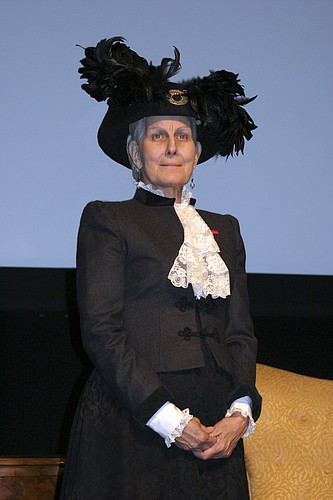- July 26, 2024
-
-
Loading

Loading

“Mary Cassatt was a rich Philadelphian. She spent most of her life in Paris where she was a pupil of Edgar Degas, with whom she probably had an affair. One of those assumptions is false.”
With these words, Jenny Aldrich launches into her celebration of Mary Cassatt’s 175th birthday. Aldrich’s tribute comes in the form of her one-woman portrayal of the pioneering woman artist at Selby Library. In the course of this belated birthday bash, you learn that …
Cassatt was an American Impressionist painter who defied the limits set for women in the 19th century.
Cassatt came from a wealthy Pennsylvania family of stockbrokers, bankers and railroad tycoons. They wanted her to be an upper-middle class wife and mother, not a professional visual artist.
But Cassatt pursued her creative ambitions anyway. She found a way to get an art education. She began creating art — and then found a way to sell it.
After getting her career off to a good start, Cassatt lost much of her early paintings in the 1871 Chicago fire.
Cassatt permanently moved to Paris in 1874. Once there, she lived the life of an artist, not a life of leisure.
She was one of only two American women to exhibit in the Paris Salon. Thanks to a personal invitation by Edgar Degas, Cassatt was the only American painter included in the Impressionists’ fourth Parisian exhibition in 1879.
In a display of both taste and business acumen, Cassatt used the money from her Impressionist art sales to buy paintings by Degas and Monet.
Degas taught Cassatt pastel and engraving techniques; Cassatt helped him crack the American art market.
Despite their divergent styles, Cassatt and Degas became quite close friends. How close? It’s impossible to say. They never married. And Cassatt destroyed all of Degas’ letters.
Cassatt remained an active part of the Impressionist circle until 1886. Her paintings were included in the first exhibition in the United States.
Cassatt was highly influenced by the 1890 exhibition of Japanese Ukiyo-e prints in Paris. Van Gogh shared her tastes.
Landscapes bored Cassatt. And she wasn’t good at painting horses. But she was good at painting women.
In an era when women were typically depicted as sex objects, saints or random faces in a crowd, Cassatt was one of the first prominent painters to take women and girls seriously as artistic subjects.
Despite a lifetime of accomplishments, Cassatt was never fully satisfied. “I did not do what I wanted to do,” she said. “But I made a good stab at it.”
These nuggets of trivia are interesting. But Aldrich’s performance is far more than a string of fun facts. It’s a theatrical show backed by projections of Cassatt’s art. However, you could close your eyes and still enjoy the show. Aldrich paints a compelling portrait of the artist with words alone.
Aldrich channels Cassatt with warmth, wit and vivacity. She makes you sense the ever-turning wheels of the artist’s creative mind. Through it all, she stays in character and that character is extremely present. You’re not passively sitting and watching a detached performance. When Aldrich takes the stage, you’re in the same room with Mary Cassatt — and she’s talking to you and interacting with you.
Aldrich’s brand of live theater is the opposite of television. It’s a suitably artistic tribute to an overlooked American artist.
Her birthday present may be late. But it’s a great one.